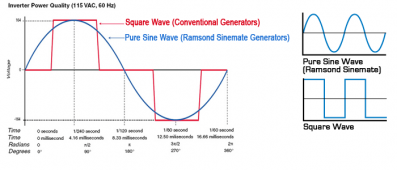I'm a little late to this party, but on our rural homestead, we use open-frame gennys for backup power, when weather or extended usage precludes solar. With a magnum 4024 inverter/charger, we pump the open-frame genny power into the inverter, and it charges the batteries just fine; it also passes through any leftover power to the house, w/o changing it any. Inverter puts out very good sine wave power, but bypass mode just passes through whatever the genny produces.
WRT to THD (of a genny), which may have become somewhat of a marketing tool to bludgeon us customers with, my findings are something along these lines:
- THD doesn't really matter ... in my entire household, I've found one item (a german countertop dishwasher) that doesn't like to run off the genny's excess power being passed through. nothing else in my household complains, or has burnt out or showed any signs of trouble.
- magnum inverter folks say "we don't care what power you feed us ... we'll take it (THD and all) all the way up to the point that *WE* decide it's crummy power, and then we might shut down". So, none of my Generac's or open-frame gennys have made it barf yet.
- most devices either don't care about THD, or care more about how much power there is, not about how clean it is. When genny is passing through power, all the microwave cares about is getting enough of it.
- most THD, and this is the jelly that is extremely hard to nail down, is caused by these two things ... your genny running at too high of a load (it's undersized), and by all the crummy devices in your household that put out THD, where this now gets thrown on the same line as incoming genny power ... your house wiring system. *your devices* putting out THD ... this seems to be a thing, from the research I'm doing.
So, to try to wrap this up ... we banned Generac, because they are too complex to work on, use only auth'd dealers, lock up their field service manual, didn't last as long as we thought it should for the initial price, and so on. We actually use TWO open-frame gennys (Duromax), and our reliability is now every bit as good as a Generac, AND, I can work on these.
We considered an inverter/generator, but they are up there in initial cost, like a Generac, and are way too complex and packed in tight to work on ourselves. Parts alone, if they break, would eat us alive, assuming we could fix it or would want to try to get in there and fix it. It might be like trying to change a battery in a sealed-up cell phone ...
So, we're sticking with open-frame gennys at this time, and THD has not been a problem for us ...
From a marketing standpoint, THD seems to be more like FUD sales tactics, but there is nothing inherently wrong with them making you pay more money for such FUD. I'm more concerned about how hard things are becoming to work on, or getting locked up behind dealers ...




